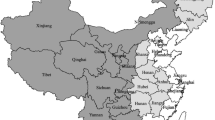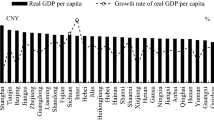Abstract
There is a growing consensus that, as part of China’s “New Normal”, economic growth will slow permanently. Given China’s geographic diversity, the slowdown will likely have differential effects on China’s provinces which will interact with existing disparities. We investigate whether confining the initial effect of an aggregate shock to one of three regions (coast, centre and west) affects the inter-provincial distribution of its effects over time. We use two alternative models: a restricted VAR model of 28 provinces and three regions and a sequence of 28 four-equation VAR models. We find that the two methods give remarkably similar results—a shock to a particular region’s output has its main effects on the provinces in that region, although this differs over time and across regions. A shock which originates in the coastal region affects mainly the coastal provinces in both the short and long runs so that a growth reduction is likely to ameliorate existing inter-provincial disparities. However, there is more diffusion of the effects of a central shock, particularly in the long run. A shock to the western region also generates spillover effects in the long run although these are to the coastal provinces so that a growth slowdown will tend to reduce existing disparities.









Similar content being viewed by others
Notes
This comparison excludes the “city-provinces” of Shanghai, Beijing and Tianjin for which the comparable ratios are even higher at 4.2, 4.3 and 4.2, respectively, in 2016. See Groenewold et al. (2008), Chapter 3, Xu et al. (2013) and Chen (2013) for more information on Chinese regional policy since the founding of the People’s Republic of China. Knight (2016) provides an interesting general discussion of the possible conflict between economic growth and other objectives, including equality. Nam (2017) reports a recent comparison of China’s regional (population) disparities to those of 100 other countries and concludes that China’s regional inequality is significantly greater than average.
See Zhang (2014) for evidence that globalisation has benefitted the coast more than the rest of the country so that we might expect the opposite when growth slows.
Originally, the Kuznets curve related the degree of household income inequality and growth, but the term has also been used to describe the relationship between regional inequality and growth (see, for example, Li and Haynes (2011), for China and Monastiriotis (2014), for the EU) and, more recently, an environmental Kuznets curve has been used to characterise the pollution–growth nexus (see, e.g., He and Yao (2017), for a recent application to China).
We note, though, that our sample period ends 2 years later than the one in Chen and Groenewold (2018). Our experimentation with a shorter period ending in 2012 shows that the results are insensitive to the inclusion of these extra 2 years.
Strictly speaking Beijing, Tianjin and Shanghai are municipalities which are under direct central government control rather than under provincial government control and in this sense have a greater similarity to provinces than to cities or municipalities. For this reason, they are commonly treated as provinces in empirical work. Hainan was separated from Guangdong province in 1988, and Chongqing was separated from Sichuan province in 1997. As a result, Wu (2004) combined Chongqing with Sichuan and Hainan with Guangdong, and we follow his scheme. Tibet is excluded due to missing data in some of years in our sample.
We realise that our assumption is not likely to be completely accurate, but that we would argue that the regions are large enough that it is likely that the one-year effects of region-specific shocks will be confined substantially to the region.
Neither model generates national IRFs and bounds. We have computed these as weighted averages of the three regional IRFs and bounds with weights equal to shares of national output averaged over 1982–2014. For the SoM approach, the regional IRFs and bounds are the averages across all 28 model iterations.
In the IRFs in Appendix, the horizons are numbered such that the shock occurs at t = 1; then, t = 2 is one period after the shock and t = 10 is nine periods after the shock. Nothing much changes to the overall characterisation of the results if we make the long run shorter than 9 periods, say, 5 periods after the shock.
In particular, we say that the provincial and national IRFs are coincident at a particular horizon if the provincial IRF lies within 5% of the distance between the national confidence bounds on either side of the national IRF at that horizon.
References
Bai C-E, Zhang Q (2017) Is the People’s Republic of China’s current slowdown a cyclical downturn or a long-term trend? A productivity-based analysis. Asian Development Bank Institute Working Paper No. 635
Bai C-E, Ma H, Pan W (2012) Spatial spillover and regional economic growth in China. China Econ Rev 23:982–990
Beckworth D (2010) One nation under the Fed? The asymmetric effects of US monetary policy and its implications for the United States as an optimal currency area. J Macroecon 32:732–746
Berg A, Ostry J (2017) Inequality and unsustainable growth: two sides of the same coin? IMF Econ Rev 65(4):792–815
Cai F (2016) China’s economic slowdown under supply-side perspective. China Econ 11(5):4–15
Carlino G, DeFina R (1998) The differential regional effects of monetary policy. Rev Econ Stat 80:572–587
Carlino G, DeFina R (1999) The differential regional effects of monetary policy: evidence from the U.S. States. J Reg Sci 39:339–358
Chan KS, Zhou X, Pan Z (2014) The growth and inequality nexus: the case of China. Int Rev Econ Financ 34:230–236
Chen A (2010) Reducing China’s regional disparities: is there a growth cost? China Econ Rev 21:2–13
Chen Z (2013) The political economy of urban and rural development in China. In: Lu M, Chen Z, Zhu X, Xu X (eds) China’s regional development. Routledge, London, pp 92–133
Chen A, Groenewold N (2018) The regional effects of macroeconomic shocks in China. China Econ Rev 48:139–154
Chen Y, Wu Y (2012) Regional economic growth and spillover effects: an analysis of China’s Pan Pearl River Delta area. China World Econ 20:80–97
Cheong TS, Wu Y (2013) Regional disparity, transitional dynamics and convergence in China. J Asian Econ 29:1–14
Fleisher B, Li H, Zhao M (2010) Human capital, economic growth, and regional inequality in China. J Dev Econ 92:215–231
Fraser P, Macdonald GA, Mullineux AW (2014) Regional monetary policy: an Australian perspective. Reg Stud 48:1419–1433
Groenewold N, Chen A, Lee G (2008) Linkages between China’s regions: measurement and policy. Edward Elgar, Cheltenham
Groenewold N, Chen A, Lee G (2010) Inter-regional spillovers of policy shocks in China. Reg Stud 44:87–101
Gu X, Tam PS (2013) The saving-growth-inequality triangle in China. Econ Model 33:850–857
Hao R, Wei Z (2010) Fundamental causes of inland–coastal income inequality in post-reform China. Ann Reg Sci 45:181–206
He X, Yao X (2017) Foreign direct investments and the environmental Kuznets curve: new evidence from Chinese provinces. Emerg Mark Financ Trade 53:12–25
Herrerías MJ (2012) Weighted convergence and regional growth in China: an alternative approach (1952–2008). Ann Reg Sci 49:685–718
Hirschman A (1958) The strategy of economic development. Yale University Press, New Haven
Jiang X, Zhang L, Xiong C, Wang R (2016) Transportation and regional economic development: analysis of spatial spillovers in China provincial regions. Netw Spat Econ 16:769–790
Kennedy T, Smyth R, Valadkhani A, Chen G (2017) Does income inequality hinder economic growth? New evidence using Australian taxation statistics. Econ Model 65:119–128
Knight J (2016) The societal cost of China’s rapid economic growth. Asian Econ Pap 15:138–159
Kuznets S (1955) Economic growth and income inequality. Am Econ Rev 45:1–28
Lastrapes WD (2005) Estimating and identifying vector autoregressions under diagonality and block exogeneity restrictions. Econ Lett 87:75–81
Lastrapes WD (2006) Inflation and the distribution of relative prices: the role of productivity and money supply shocks. J Money, Credit, Bank 38:2159–2198
Lemoine F, Poncet S, Unal D (2015) Spatial rebalancing and industrial convergence in China. China Econ Rev 34:39–63
Li G, Fang C (2014) Analyzing the multi-mechanism of regional inequality in China. Ann Reg Sci 52:155–182
Li H, Haynes KE (2011) Economic structure and regional disparity in China: beyond the Kuznets tradition. Int Reg Sci Rev 34:157–190
Lim GC, McNelis PD (2016) Income growth and inequality: the threshold effects of trade and financial openness. Econ Model 58:403–412
Lin JY, Wan G, Morgan PJ (2016) Prospects for a re-acceleration of economic growth in the PRC. J Comp Econ 44:842–853
Lou J (2016) The possibility and approaches to an upper middle growth rate. Front Econ China 11(2):196–209
Lu D (2017) China’s growth slowdown and prospects for becoming a high-income developed economy. Asian Econ Pap 16(1):89–113
Madsen JB, Islam MR, Doucouliagos H (2018) Inequality, financial development and economic growth in the OECD, 1870–2011. Eur Econ Rev 101:605–624
Monastiriotis V (2014) Regional growth and national development: transition in central and eastern Europe and the regional Kuznets curve in the East and the West. Spat Econ Anal 9:142–161
Myrdal G (1957) Economic theory and underdeveloped regions. Duckworth, London
Nam K-M (2017) Is spatial distribution of China’s population excessively unequal? A cross-country comparison. Ann Reg Sci 59:453–474
National Statistical Bureau (2009) New China 60 years statistics compilation. Statistical Publishing House of China, Beijing
National Statistical Bureau (Various issues) China Statistical Yearbook. Beijing: Statistical Publishing House of China
Ridhwan MM, de Groot HLF, Rietveld P, Nijkamp P (2014) The regional impact of monetary policy in Indonesia. Growth Change 45(2):240–262
Risso WA, Sanchez Carrera EJ (2012) Inequality and economic growth in China. J Chin Econ Foreign Trade Stud 5:80–90
Su J, Jefferson GH (2012) Differences in returns to FDI between China’s coast and interior: one country, two economies? J Asian Econ 23:259–269
Wan G, Lu M, Chen Z (2006) The inequality-growth nexus in the short and long run: empirical evidence from China. J Comp Econ 34:654–667
Wang H, Rickman D (2018) Regional growth differences in China for 1995–2013: an empirical integrative analysis of their sources. Ann Reg Sci 60:99–117
Wang Y, Ning L, Li J, Prevezer M (2016) Foreign direct investment spillovers and the geography of innovation in Chinese regions: the role of regional industrial specialization and diversity. Reg Stud 50:805–822
Whalley J, Zhang S (2007) A numerical simulation analysis of (Hukou) labour mobility restrictions in China. J Dev Econ 83:392–410
Wu Y (2004) China’s economic growth: a miracle with Chinese characteristics. Routledge Curzon, London
Xu X, Wang X, Gao Y (2013) The political economy of regional development in China. In: Lu M, Chen Z, Zhu X, Xu X (eds) China’s regional development. Routledge, London, pp 41–90
Zhang KH (2014) Globalization and regional industrial performance: evidence from China. Pap Reg Sci 93:269–280
Acknowledgements
An earlier version of this paper was presented at the Workshop on Regional, Urban and Spatial Economics at South-West University of Finance and Economics in Chengdu and at the Meeting of the European Regional Science Association in Vienna. We are grateful for useful comments received there. We have also benefitted from helpful comments by the editor and two anonymous referees. The research reported in this paper was partially funded by a National Natural Science Foundation of China Grant (No. 71773036).
Author information
Authors and Affiliations
Corresponding author
Rights and permissions
About this article
Cite this article
Chen, A., Groenewold, N. Macroeconomic shocks in China: Do the distributional effects depend on the regional source?. Ann Reg Sci 62, 69–97 (2019). https://doi.org/10.1007/s00168-018-0885-2
Received:
Accepted:
Published:
Issue Date:
DOI: https://doi.org/10.1007/s00168-018-0885-2




